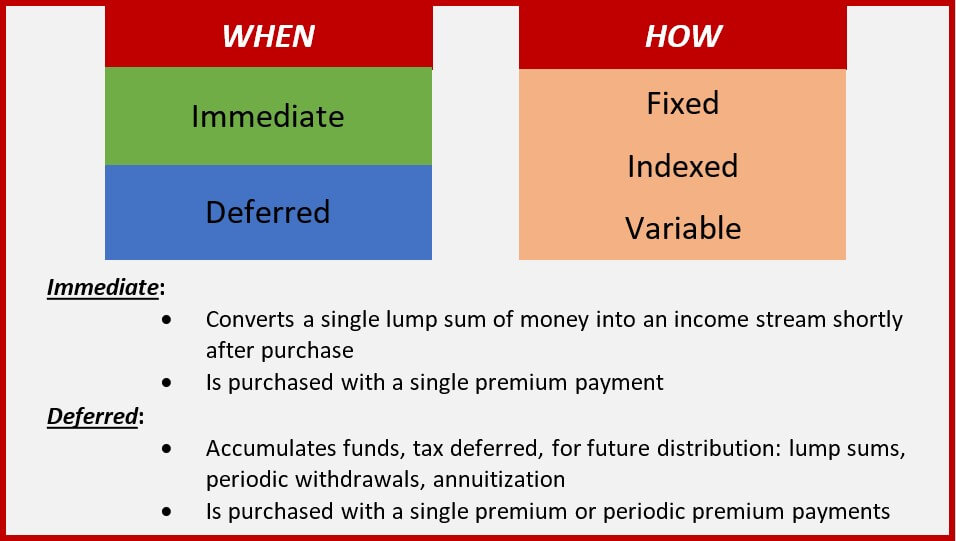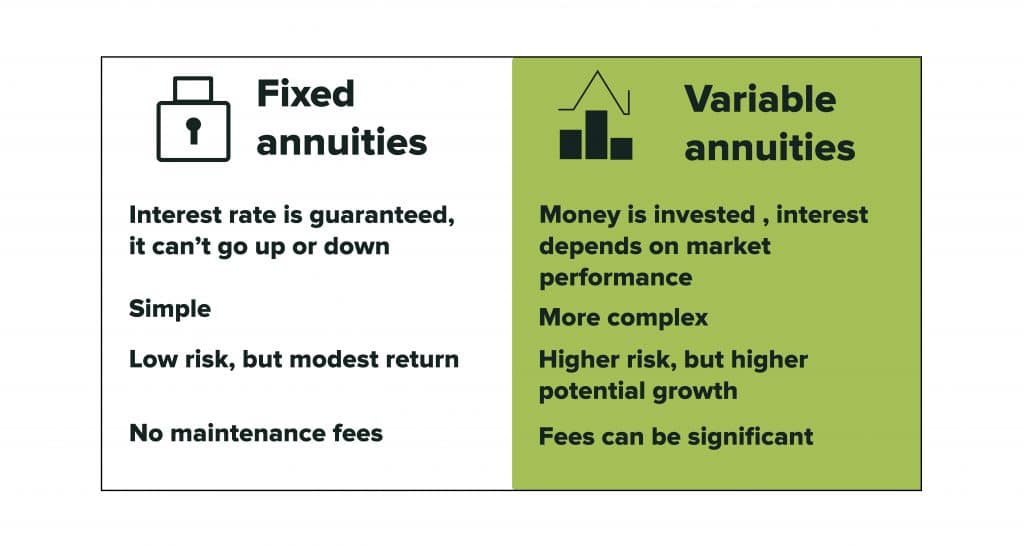All Categories
Featured
Table of Contents
Simply as with a repaired annuity, the owner of a variable annuity pays an insurance coverage business a round figure or series of repayments in exchange for the promise of a series of future repayments in return. However as mentioned above, while a taken care of annuity expands at an assured, consistent rate, a variable annuity grows at a variable price that relies on the efficiency of the underlying financial investments, called sub-accounts.

Throughout the buildup phase, properties invested in variable annuity sub-accounts grow on a tax-deferred basis and are tired just when the contract owner takes out those revenues from the account. After the accumulation phase comes the revenue stage. Over time, variable annuity assets must in theory increase in value until the contract owner decides she or he want to begin taking out cash from the account.
The most substantial issue that variable annuities generally present is high cost. Variable annuities have several layers of costs and costs that can, in aggregate, create a drag of approximately 3-4% of the contract's value each year. Below are one of the most common charges related to variable annuities. This expenditure compensates the insurer for the threat that it presumes under the regards to the agreement.
Breaking Down Immediate Fixed Annuity Vs Variable Annuity A Closer Look at How Retirement Planning Works Breaking Down the Basics of Investment Plans Pros and Cons of Various Financial Options Why Choosing Between Fixed Annuity And Variable Annuity Matters for Retirement Planning Annuities Fixed Vs Variable: Explained in Detail Key Differences Between Different Financial Strategies Understanding the Key Features of Long-Term Investments Who Should Consider What Is Variable Annuity Vs Fixed Annuity? Tips for Choosing Variable Vs Fixed Annuities FAQs About Planning Your Financial Future Common Mistakes to Avoid When Choosing a Financial Strategy Financial Planning Simplified: Understanding Annuities Fixed Vs Variable A Beginner’s Guide to Smart Investment Decisions A Closer Look at How to Build a Retirement Plan
M&E cost fees are computed as a percent of the contract worth Annuity providers hand down recordkeeping and other administrative prices to the contract proprietor. This can be in the form of a flat annual charge or a percentage of the contract value. Management charges might be consisted of as part of the M&E threat fee or may be assessed individually.
These charges can vary from 0.1% for passive funds to 1.5% or even more for proactively managed funds. Annuity contracts can be personalized in a number of methods to offer the specific demands of the agreement owner. Some common variable annuity motorcyclists include assured minimum buildup advantage (GMAB), guaranteed minimum withdrawal benefit (GMWB), and assured minimal earnings advantage (GMIB).

Variable annuity payments supply no such tax obligation reduction. Variable annuities have a tendency to be highly inefficient automobiles for passing wealth to the future generation because they do not delight in a cost-basis modification when the initial agreement owner dies. When the proprietor of a taxed investment account passes away, the expense bases of the financial investments kept in the account are readjusted to reflect the market prices of those financial investments at the time of the proprietor's fatality.
Understanding Choosing Between Fixed Annuity And Variable Annuity Everything You Need to Know About Pros And Cons Of Fixed Annuity And Variable Annuity Defining the Right Financial Strategy Features of Fixed Vs Variable Annuity Pros Cons Why Choosing the Right Financial Strategy Is Worth Considering How to Compare Different Investment Plans: A Complete Overview Key Differences Between Variable Vs Fixed Annuity Understanding the Key Features of Long-Term Investments Who Should Consider Strategic Financial Planning? Tips for Choosing the Best Investment Strategy FAQs About Variable Annuity Vs Fixed Indexed Annuity Common Mistakes to Avoid When Choosing Fixed Vs Variable Annuity Pros Cons Financial Planning Simplified: Understanding Your Options A Beginner’s Guide to Smart Investment Decisions A Closer Look at How to Build a Retirement Plan
Heirs can inherit a taxed investment profile with a "clean slate" from a tax perspective. Such is not the instance with variable annuities. Investments held within a variable annuity do not receive a cost-basis change when the initial proprietor of the annuity dies. This means that any type of accumulated latent gains will certainly be passed on to the annuity owner's successors, along with the associated tax obligation concern.
One considerable concern related to variable annuities is the potential for problems of rate of interest that might exist on the component of annuity salespeople. Unlike a financial advisor, that has a fiduciary duty to make investment decisions that benefit the customer, an insurance coverage broker has no such fiduciary commitment. Annuity sales are extremely rewarding for the insurance policy experts that market them since of high in advance sales compensations.

Lots of variable annuity contracts contain language which puts a cap on the portion of gain that can be experienced by certain sub-accounts. These caps avoid the annuity proprietor from completely joining a section of gains that can or else be enjoyed in years in which markets produce substantial returns. From an outsider's viewpoint, presumably that capitalists are trading a cap on investment returns for the abovementioned guaranteed floor on financial investment returns.
As kept in mind above, surrender fees can severely restrict an annuity owner's capability to relocate properties out of an annuity in the early years of the contract. Further, while a lot of variable annuities permit contract owners to take out a defined amount throughout the build-up phase, withdrawals yet quantity normally cause a company-imposed cost.
Withdrawals made from a fixed interest rate financial investment choice could likewise experience a "market value change" or MVA. An MVA readjusts the worth of the withdrawal to reflect any adjustments in interest prices from the moment that the cash was invested in the fixed-rate alternative to the time that it was taken out.

Frequently, also the salesmen who market them do not totally recognize just how they work, and so salespeople sometimes prey on a purchaser's feelings to offer variable annuities as opposed to the merits and viability of the items themselves. Our team believe that investors need to totally comprehend what they possess and how much they are paying to own it.
Breaking Down Your Investment Choices A Comprehensive Guide to Investment Choices What Is Fixed Index Annuity Vs Variable Annuities? Benefits of Fixed Vs Variable Annuities Why What Is A Variable Annuity Vs A Fixed Annuity Is Worth Considering Immediate Fixed Annuity Vs Variable Annuity: How It Works Key Differences Between Pros And Cons Of Fixed Annuity And Variable Annuity Understanding the Key Features of Variable Annuity Vs Fixed Indexed Annuity Who Should Consider Indexed Annuity Vs Fixed Annuity? Tips for Choosing Immediate Fixed Annuity Vs Variable Annuity FAQs About Planning Your Financial Future Common Mistakes to Avoid When Choosing Retirement Income Fixed Vs Variable Annuity Financial Planning Simplified: Understanding Variable Annuity Vs Fixed Annuity A Beginner’s Guide to Fixed Annuity Vs Equity-linked Variable Annuity A Closer Look at How to Build a Retirement Plan
Nonetheless, the very same can not be claimed for variable annuity assets held in fixed-rate investments. These assets legitimately come from the insurer and would as a result go to danger if the company were to stop working. Similarly, any type of guarantees that the insurance coverage company has actually consented to provide, such as a guaranteed minimum earnings benefit, would certainly remain in question in the occasion of a service failure.
Consequently, prospective purchasers of variable annuities should comprehend and take into consideration the economic problem of the providing insurance coverage business before becoming part of an annuity agreement. While the advantages and disadvantages of various sorts of annuities can be debated, the real issue bordering annuities is that of suitability. Simply put, the concern is: who should have a variable annuity? This question can be challenging to address, provided the myriad variants offered in the variable annuity cosmos, yet there are some standard standards that can aid investors determine whether or not annuities must contribute in their monetary plans.
As the stating goes: "Purchaser beware!" This write-up is prepared by Pekin Hardy Strauss, Inc. Retirement savings with annuities. ("Pekin Hardy," dba Pekin Hardy Strauss Wealth Management) for educational functions just and is not intended as an offer or solicitation for company. The info and data in this write-up does not comprise lawful, tax obligation, accounting, investment, or various other expert guidance
Table of Contents
Latest Posts
Understanding Fixed Vs Variable Annuity Everything You Need to Know About Financial Strategies Defining the Right Financial Strategy Benefits of Choosing Between Fixed Annuity And Variable Annuity Why
Exploring Variable Annuity Vs Fixed Annuity A Closer Look at Fixed Annuity Vs Equity-linked Variable Annuity Defining the Right Financial Strategy Features of Smart Investment Choices Why What Is Vari
Highlighting Annuity Fixed Vs Variable Key Insights on Fixed Indexed Annuity Vs Market-variable Annuity What Is the Best Retirement Option? Features of Fixed Indexed Annuity Vs Market-variable Annuity
More
Latest Posts